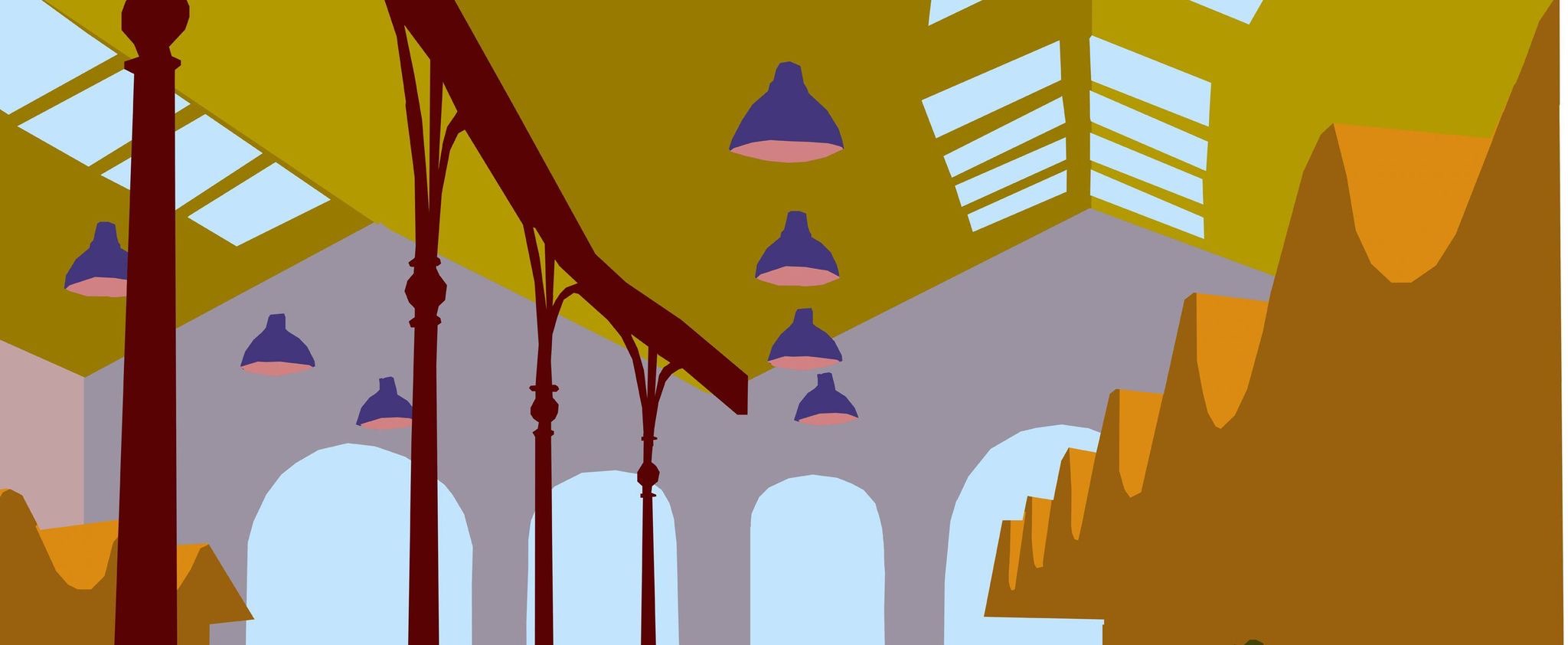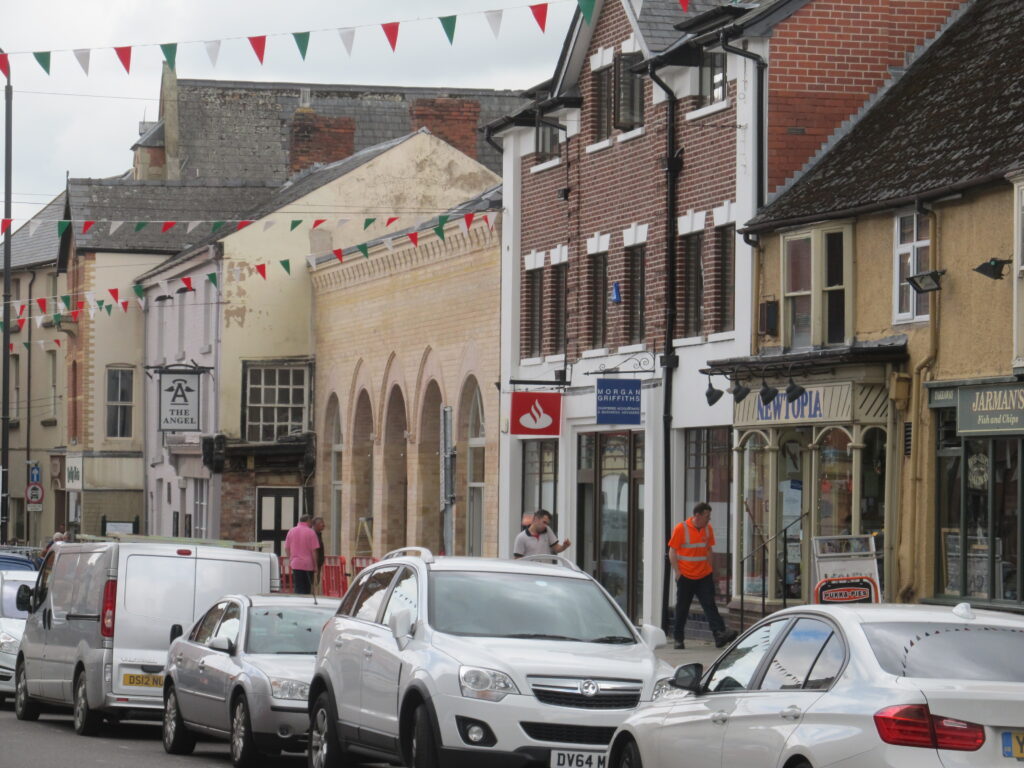A building shrouded in history…
-
In 1868 Wastel Brisco instructed his agent in Newtown, Thomas Sturkey, to have some of his properties in High Street and Market Street demolished and an imposing market hall built in their place. The Liverpool architect, David Walker, was engaged to draw up plans which included imposing yellow brick and terracotta facades open at both Market Street and High Street entrances. Mr Williams of Llanidloes was the builder. Dennis Taylor was appointed Caretaker/Superintendent for the Market Hall. He lived at 8 Frolic Street with his wife Harriet and his three sons and two daughters (Dennis, George, Robert, Rose and Lily). The new building was opened a few days before Christmas in 1870. The key was turned by Thomas Sturkey’s young son Owen.
Not wishing to have the expense of running the building himself, Wastel Brisco immediately offered the Market Hall to Newtown Local Board, either for sale or rent. The asking price was £5,000. The Board asked Evan Powell to do a valuation of the building. He came up with the remarkably precise figure of £3,868 12s 8d. Although Brisco reduced his price, many in the town felt the amount that he was asking was still exorbitant. In addition to this they were outraged that they had not been consulted over decisions such as where the market would be built, how large it would be and how much it would cost. As discussions continued, the opinions of those who lived in the town began to divide. Those who felt the Market Hall should be purchased believed that Mr Brisco was a generous benefactor to the town and should be shown gratitude for providing the people of Newtown, not only with a fine Market Hall, but many other buildings in the town. Others were violently opposed to this view, convinced that Mr Brisco was only out to make a profit for himself. In March 1871, these contradicting views eventually lead to violence on the streets of Newtown. Unable to come to an agreement on the ‘Market Hall Question’ a poll had taken place asking the ratepayers in the Newtown district if they wanted to purchase the building. Canvassing on both sides was rowdy with many accusations of cheating. Eventually, the people voted in favour of the Newtown Local Board buying or renting the hall from Mr Brisco. However, this was not the end of the matter. Many were not happy and the scene that followed was one of chaos with crowds shouting, fighting and running along the streets, hurling stones through windows and generally causing trouble.
Eventually, after calling for additional policemen to calm the situation, the streets gradually began to empty. A decision, it seemed, had been made. The Council now sought to come to a financial arrangement with Mr Brisco for the purchase of the hall. Many letters were written and offers made but the gap between seller and purchaser could not be closed and it was to be another 50 years before the matter was finally resolved. In the meantime, the Market Hall was soon pressed into service as a public meeting place for events and entertainments. In 1876 the floor of the hall was regularly used as a roller skating rink with community teas, dances and political speeches all taking place in this new large public space.The row over the proposed purchase of the market hall continued over the years with ‘The Market Hall Question’ rarely out of the local news. In July 1893 there was an ‘uproarious’ meeting of ratepayers. They decided not to do anything for six months but still ‘the meeting then broke up in confusion’. At the end of six months, in January 1894, another attempt was made at a meeting in the Victoria Hall. There were ‘uproarious scenes and general ructions’ and the matter was again adjourned, this time for a year. Despite this resolution another meeting was held the following March. Once again there was considerable interruption and uproar and the meeting was of a most animated character from beginning to end. Again no decision emerged. The Brisco family raised the matter again in 1913 when the owner of Newtown Hall estate, Captain R J W Arbuthnot-Brisco offered to sell the Market Hall to the Urban District Council for £5,850. The Council remembered that 40 years earlier the asking price had been £5,000. To increase the price ‘after all those years of wear and tear’ the councillors considered to be outrageous. The offer was refused.
The Great War changed everything. When it ended in 1918 the country’s great estates were left with huge land taxes to pay. The Newtown Hall estate was no exception, much of its property had to be put on the market to raise the cash to pay what was owed. With so much property being put on the market at the same time prices were seriously deflated. The UDC was able to get the Market Hall for £3,500. Stamp duty, legal costs and repairs brought the total up to£4,273 12s 8d, less than they had been asked for the Hall 50 years earlier. The building that the council took possession of was, however, no longer in its original condition. To celebrate Queen Victoria’s Diamond Jubilee in 1897 Miss Sarah Brisco of Newtown Hall had decided to demolish some of her properties in The Cross and replace them with the present Cross Buildings. This involved the removal of three shops. One of these had been empty for some time but the other two housed long standing tenants. W H Lambert, Chemist and Jones Brothers, Ironmongers. When the building was completed they would be able to return to the premises but meanwhile temporary accommodation had to be found for their businesses.
This was achieved by brutally hacking away most of David Walkers’ lofty arcade at the High Street end of the Market Hall and inserting shop fronts on either side of the entrance. In 1900 Messrs Lambert and Jones Bros returned to the Cross. Their temporary shops in the Market Hall remain.Once under municipal control the Market Hall ceased to be a matter of front page news until 1939 when the outbreak of the Second World War again brought a change to the Market Halls’ circumstances. Many of the town’s buildings were requisitioned for government or military use. In 1941 a partition wall was built down the middle of the building and the eastern side of the Market Hall became one of five buildings in town housing an Admiralty Victualing Depot. During the hostilities the Royal Navy’s stock of Rum was said to have been kept in Newtown. When the war ended that part of the building then became a Ministry of Food Buffet Depot. In 1954 the building was derequisitioned and the space rented to G.H.Rees, corn merchant, who had his business next door at 30 Market Street (now BJ’s). The entire Market Hall was not returned to public use until 1959, when the Urban District Council undertook refurbishments and had 12 lock-up shops built inside, which they rented out.
During successive local government reorganisations the building has passed from Newtown and Llanllwchaiarn Urban District Council to Montgomery District Council to Powys County Council , then finally Powys County Council transfered the property for refurbishment on a 99 year lease to Mid Wales Food and Land Trust in 2014



